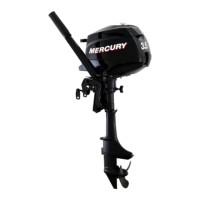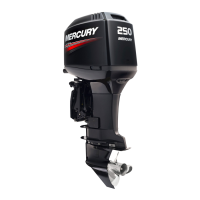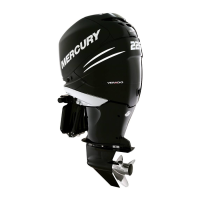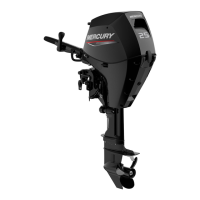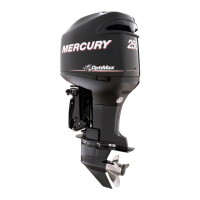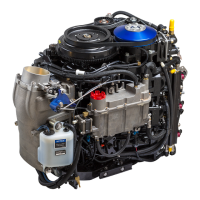90-10100R30
7
GB
ob
GENERAL INFORMATION
oba1
BOATER’S RESPONSIBILITIES
The operator (driver) is responsible for the correct and safe operation of the boat and
safety of its occupants and general public. It is strongly recommended that each
operator (driver) read and understand this entire manual before operating the outboard.
Be sure at least one additional person on board is instructed in the basics of starting
and operating the outboard and boat handling in case the driver is unable to operate
the boat.
obb1
BEFORE OPERATING YOUR OUTBOARD
Read this manual carefully. Learn how to operate your outboard properly. If you
have any questions, contact your dealer.
Safety and operating information that is practiced along with using good common
sense can help prevent personal injury and product damage.
This manual as well as safety labels posted on the outboard use the following
safety alerts to draw your attention to special safety instructions that should be
followed.
DANGER
DANGER - Immediate hazards which WILL result in severe personal inju-
ry or death.
WARNING
WARNING - Hazards or unsafe practices which COULD result in severe
personal injury or death.
CAUTION
CAUTION - Hazards or unsafe practices which could result in minor injury
or product or property damage.
gob1
U.S. COAST GUARD CAPACITY
MAXIMUM HORSEPOWER XXX
MAXIMUM PERSON
CAPACITY (POUNDS) XXX
MAXIMUM WEIGHT
CAPACITY XXX
1
obc1
BOAT HORSEPOWER CAPACITY
1
Do not overpower or overload your boat. Most boats will carry a required
capacity plate indicating the maximum acceptable power and load as
determined by the manufacturer following certain federal guidelines. If in doubt,
contact your dealer or the boat manufacturer.
WARNING
Using an outboard that exceeds the maximum horsepower limit of a
boat can: 1. cause loss of boat control 2. place too much weight at the
transom altering the designed flotation characteristics of the boat or 3.
cause the boat to break apart particularly around the transom area.
Overpowering a boat can result in serious injury, death or boat dam-
age.
gob2
2
1
obg6
LANYARD STOP SWITCH
1
The purpose of a lanyard stop switch is to turn off the engine when the operator
moves far enough away from the operator’s position (as in accidental ejection
from the operator’s position) to activate the switch. Tiller handle outboards and
some remote control units are equipped with a lanyard stop switch. A lanyard
stop switch can be installed as an accessory – generally on the dashboard or
side adjacent to the operator’s position.
2 The lanyard is a cord usually between 4 and 5 feet (1220 and 1524 mm) in
length when stretched out with an element on one end made to be inserted into
the switch and a snap on the other end for attaching to the operator. The
lanyard is coiled to make its at-rest condition as short as possible so as to
minimize the likelihood of lanyard entanglement with nearby objects. It is made
as long as it is in its stretched condition to minimize the likelihood of accidental
activation should the operator choose to move around in an area close to the
normal operator’s position. If it is desired to have a shorter lanyard, wrap the
lanyard around the operator’s wrist or leg, or tie a knot in the lanyard.
Read the following Safety Information before proceeding.
Important Safety Information: The purpose of a lanyard stop switch is to stop
the engine when the operator moves far enough away from the operator’s position
to activate the switch. This would occur if the operator accidentally falls overboard
or moves within the boat a sufficient distance from the operator’s position.
Accidental ejections and falls overboard are more likely to occur in certain types
of boats such as low sided inflatables or bass boats, high-performance boats and
light, sensitive-handling fishing boats operated by hand-tiller. Accidental ejections
and falls overboard are also likely to occur as a result of poor operating practices
such as sitting on the back of the seat or gunwale at planing speeds, standing at
planing speeds, sitting on elevated fishing boat decks, operating at planing speeds
in shallow or obstacle-infested waters, releasing your grip on a steering wheel or
tiller handle that is pulling in one direction, drinking alcohol or consuming drugs,
or daring, high-speed boat maneuvers.
While activation of the lanyard stop switch will stop the engine immediately, a boat
will continue to coast for some distance depending upon the velocity and degree
of any turn at shut-down. However, the boat will not complete a full circle. While
the boat is coasting, it can cause injury to anyone in the boat’s path as seriously
as the boat would when under power.
We strongly recommend that other occupants be instructed on proper starting and
operating procedures should they be required to operate the engine in an
emergency (e.g. if the operator is accidentally ejected).
WARNING
Should the operator fall out of the boat, the possibility of serious inju-
ry or death from being run over by the boat can be greatly reduced by
stopping the engine immediately. Always properly connect both ends
of the stop switch lanyard – to the stop switch and the operator.
Accidental or unintended activation of the switch during normal operation is also
a possibility. This could cause any, or all, of the following potentially hazardous
situations:
1. Occupants could be thrown forward due to unexpected loss of forward motion
– a particular concern for passengers in the front of the boat who could be
ejected over the bow and possibly struck by the gear case or propeller.
2. Loss of power and directional control in heavy seas, strong current or high
winds.
3. Loss of control when docking.
WARNING
Avoid serious injury or death from deceleration forces resulting from
accidental or unintended stop switch activation. The boat operator
should never leave the operator’s station without first disconnecting
the stop switch lanyard from the operator.
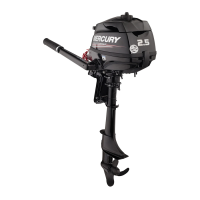
